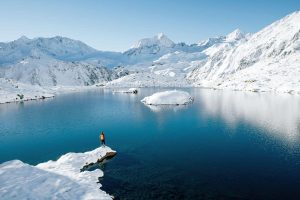While beautiful autumn atmospheres prevail in the valley, an early cold snap in the mountains has already ushered in winter. The snow cover and the cold temperatures currently make mountain tours over 1.500 meters challenging and require carefully considered and adapted tour planning. The Alpine Club gives safety tips after the first onset of winter of the season.
After a very stable autumn with the warmest September in the 257-year history of measurements (source: GeoSphere Austria), winter is knocking on the door: In the Eastern Alps, considerable amounts of new snow have fallen on the higher mountains in the last few days, some of which were considerable. The avalanche warning services have also started their work and pointed out the winter conditions in the mountains with their first blog entries. The first official avalanche reports are already available in Switzerland. “At lower altitudes, the snow will probably melt again on the south side due to the forecast mild temperatures and the still warm ground, says Gerhard Mössmer, mountain sports expert from the Austrian Alpine Club. “Due to the considerable amounts, the snow in the high Alps will probably remain until winter.”
Onset of winter: Note current conditions
The first ski tours are already possible - especially near the slopes of the glacier ski areas. The same safety measures as in midwinter must be observed and full equipment must be carried (LVS, shovel, probe, first aid, bivouac bag, cell phone). “Especially after the first snowfall, you should also watch out for hidden stones and wear a helmet. Crevasses are also a source of danger: every year around this time there are falls through crevasses that are only lightly covered in snow,” informs Gerhard Mössmer.
Snow and cold temperatures change a lot in the mountains: “As paths become icy, easy walking terrain can quickly turn into a technically difficult passage, for example on steep slabs,” explains Gerhard Mössmer. Finding your way also becomes more difficult because paths and markings are less visible. In the first one or two days after the cold front passes, ice falls from icicles can also occur when climbing along rock faces.
For anyone who still wants to go to the mountains in the next few days, careful tour planning is essential: south-facing hikes in the low mountain ranges and via ferratas near the valley are currently available. It is also important to take into account the rapidly shorter days and adjust the length of the tour accordingly. The exposure of the tour or via ferrata should also be taken into account: While it can quickly become snowy again on the south side, there is often snow on the north side for a long time. “This becomes an issue especially on tours lasting several days and overruns. Here it can make sense to avoid tricky passages by – if possible – descending into the valley and bypassing the route using public transport,” says Gerhard Mössmer. In general, it makes sense to find out as much information as possible about the current conditions before the planned tour, for example by looking at the webcams, doing an internet search or calling the nearest hut.
Tour planning made easy!
It is often not easy to choose the right tour for the current conditions on the mountain. To make it easier to independently select tours for various mountain activities, mountain enthusiasts can use the platform www.alpenvereinaktiv.com and the associated app from the Austrian Alpine Club. The current conditions in the high mountains can also be found there. The Alpine Club recommends sturdy, high-heeled shoes as well as gloves and warm clothing.




